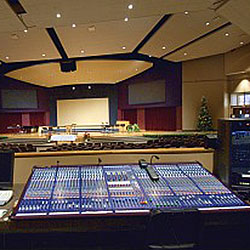
What do you get for your money? Given the same number of mic inputs, as the price climbs you’ll first start to see added flexibility.
The signal flow diagram will blossom into a city map. You’ll go from three or four auxiliary sends to six or eight.
At first they’ll probably be grouped as either prefade or postfade in groups of two or four. That’s a limitation.
You’ll also start to see submasters on the console. At first you’ll see four submasters, then as the price climbs it will jump to eight.
Next you may start to see added switching. For example, you’ll reach a point where you get that pre/post switch I mentioned earlier next to every auxiliary send pot. This is way cool.
Go a little higher and you might even see a Mute switch next to every auxiliary send pot. Now, this is beyond cool. You could also find programmable mutes – a method of turning on or off a group of inputs, regardless of the subgroup they are assigned to.
While there are some exceptions in the lower-priced consoles, somewhere in the $20,000 to $30,000 range you may start to hear a difference in the consoles.
Here the design intent grows beyond function to improving sound quality. Circuit design is approached differently. Much higher grade components are used, and the layout may become more critical.
If your budget has lasted this far, you might start seeing VCA subgroups. Let’s imagine that you want to control all of the vocal mics with one submaster fader.
With a standard submaster, the combined audio signal from all of those channels assigned to that submaster would flow through that submaster fader.
From a functional standpoint, that’s a bit of a limitation because the audio going through the individual channel faders is still there, even though you’ve dropped them from the house mix by pulling down the submaster.
One problem with this is the fact that, since the fader is still up, the audio is still passing on to the auxiliary sends; so if you’re feeding a signal to an effects device on one or more of those channels (e.g., reverb for vocals!?!), your audience may hear your worship team ask with a great reverberant sound “What’s for lunch?” while the pastor is reading the announcements.
With a VCA (Voltage Controlled Amplifier) approach, the audio doesn’t actually flow through the faders. Instead, it goes through a VCA on each channel. The submaster faders also have no audio passing through them.
Instead, they simply alter the control voltage that is fed to each of those channel VCA’s. So when you pull down this type of VCA submaster, it actually does turn down the audio signal at each of those individual channels.
That, in turn, drops the signal going to those aux sends and anywhere else it might be being fed to.
So how much should you spend? I can’t tell you. Well, I could, but you might not like my answer.
Consider that next to your loudspeaker system (including the processing and amps that drive it), the house console is the next most important and significant investment you’ll make toward your sound system’s quality.
Take your time, do your homework, and then have fun. You’re going to be mixing on that desk for a long time. And be sure you establish a budget now for its replacement!
Curt Taipale heads up Church Soundcheck, a thriving community dedicated to helping technical worship personnel, and he also provides expert systems design and consulting services with Taipale Media Systems.
